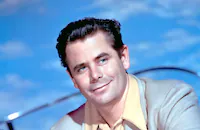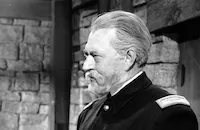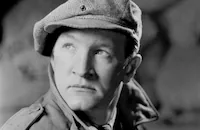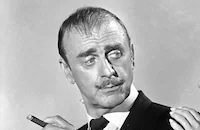The Flying Missile
Cast & Crew
Henry Levin
Glenn Ford
Viveca Lindfors
Henry O'neill
Carl Benton Reid
Joe Sawyer
Film Details
Technical Specs

Synopsis
During war games, it becomes apparent to the U.S. Navy that current submarine torpedoes are inadequate against highly developed anti-submarine devices. Realizing that new equipment is needed, Commander William A. Talbot asks that he and his men receive training in experimental guided missiles at Point Mugu Naval Base in California. Despite a lack of funding, his request is approved, but the instruction time is limited. At Point Mugu, Talbot reports to Admiral Scott and meets Scott's attractive secretary, Karin Hansen. The crew starts training the next day, but Talbot grows impatient with the slow and detailed instruction. The men practice shooting the missiles on a practice range, but Talbot wants to see how the missiles function on a submarine. Talbot and his men decide to "requisition" the parts and build their own launcher. While Talbot is at the officers' club dancing with Karin, his men steal the necessary parts. Unknown to them, they have been photographed by a photo-electric camera, but rather than arrest them, Scott decides to watch their progress. The men finish their launcher only to learn that the last missile has been used. Shortly before the end of his assignment, Talbot tells Karin he loves her. During the conversation, Karin inadvertently discloses that more missiles are stored at the ordnance depot at nearby Point Hueneme, and Talbot sets out to acquire some missiles from them. With much effort, Talbot tracks down General Benton, the commander of the depot, who agrees to give him three missiles. In talking to Benton, Talbot reveals that Karin supplied the missile location, and she loses her job with Scott. Talbot's test launch is plagued by trouble. Because the crew must leave the following day, some of the safety procedures are neglected to expedite the test, and the missile explodes, injuring Talbot and killing "Fuss" Payne, a member of his crew. In the hospital, a recovering Talbot continues to re-design the missile launcher and is informed that he will be stationed at Point Mugu to continue the work. When Talbot learns of Fuss's death, however, he has a psychosomatic reaction and loses the use of his legs. Despite his paralysis, Talbot invents a firing key that will not fire unless all safety devices are engaged. Between them, Scott and Karin scheme successfully to convince Talbot that he can walk. New war games prove the soundness of Talbot's designs, and he is reunited with Karin.

Director

Henry Levin
Cast

Glenn Ford

Viveca Lindfors

Henry O'neill

Carl Benton Reid

Joe Sawyer

John Qualen

Anthony Ross
Harry Shannon
Ross Ford
Zachary A. Charles

Jerry Paris

Kenneth Tobey

Paul Harvey
Grandon Rhodes
James Seay
Bill Donnelly

Richard Quine
Charles Evans

Peter Thompson

John Dehner

Harlan Warde
John R. Hamilton
Harry Cheshire
Anthony Jochim
Helen Spring
Helen Brown

John Doucette
Robert Bice
William Tannen

Joseph Crehan
Leon Lontoc

Paul Dubov
William Lechner
Robert Lowell
Selmer Jackson
Mary Alan Hokanson
Harry Lauter
Paul Marion
Frank Wilcox
Carleton Young
Steven Clark
John Baer
Hugh Beaumont
Ed Kelly
William S. Phillips
Crew
Jerry Bresler
George Brooks
George Cooper
Louis Diage
Paul Donnelly
George Duning
Rear Admiral Thomas M. Dykers Usn (ret)
Richard English
James Gunn
Harvey S. Haislip
Viola Lawrence
Jean Louis
N. Richard Nash
William Snyder
Maurice Stoloff

Film Details
Technical Specs

Articles
Kenneth Tobey (1917-2003)
Born in Oakland, California on March 23, 1917, Tobey originally intended to be a lawyer before a stint with the University of California Little Theater changed his mind. From there, he went straight to New York and spent nearly two years studying acting at the Neighborhood Playhouse, where his classmates included Gregory Peck, Eli Wallach and Tony Randall. Throughout the '40s, Tobey acted on Broadway and in stock before relocating to Hollywood. Once there, Tobey soon found himself playing a tough soldier in films like I Was a Male War Bride and Twelve O' Clock High (both 1949); or a tough police officer in Kiss Tomorrow Goodbye and Three Secrets (both 1950). Such roles were hardly surprising, given Tobey's craggy features, unsmiling countenance and rough voice.
Needless to say, no-nonsense, authority figures would be Tobey's calling for the remainder of his career; yet given the right role, he had the talent to make it memorable: the smart, likeable Captain Hendrey in The Thing From Another World (1951); the gallant Colonel Jack Evans in the "prehistoric dinosaur attacks an urban center" genre chiller The Beast from 20,000 Fathoms (1953, a must-see film for fans of special effects wizard, Ray Harryhausen; and as Bat Masterson, holding his own against Kirk Douglas and Burt Lancaster in Gunfight at the O.K. Corral (1957).
Television would also offer Tobey much work: he had his own action series as chopper pilot Chuck Martin in Whirlybirds (1957-59); and had a recurring role as Assistant District Attorney Alvin in Perry Mason (1957-66). He would also be kept busy with guest appearances in countless westerns (Gunsmoke, Bonanza, The Virginian) and cop shows (The Rockford Files, Barnaby Jones, Ironside) for the next two decades. Most amusingly, the tail end of Tobey's career saw some self-deprecating cameo spots in such contemporary shockers as The Howling (1981); Strange Invaders (1983) and his role reprisal of Captain Hendry in The Attack of the B-Movie Monsters (2002). Tobey is survived by a daughter, two stepchildren, and two grandchildren.
by Michael T. Toole

Kenneth Tobey (1917-2003)
Quotes
Trivia
Notes
The film begins with the following written foreword: "For security reasons no motion picture on this subject has previously been permitted. Now however, through the full cooperation of our armed forces, this motion picture was filmed on board submarines, surface ships and shore installations of the Navy and Army. Much of it was made at the Naval Air Missile Test Center at Point Mugu, California. To the officers and men and to all others engaged in promoting the security of our great nation this picture is respectfully dedicated."














